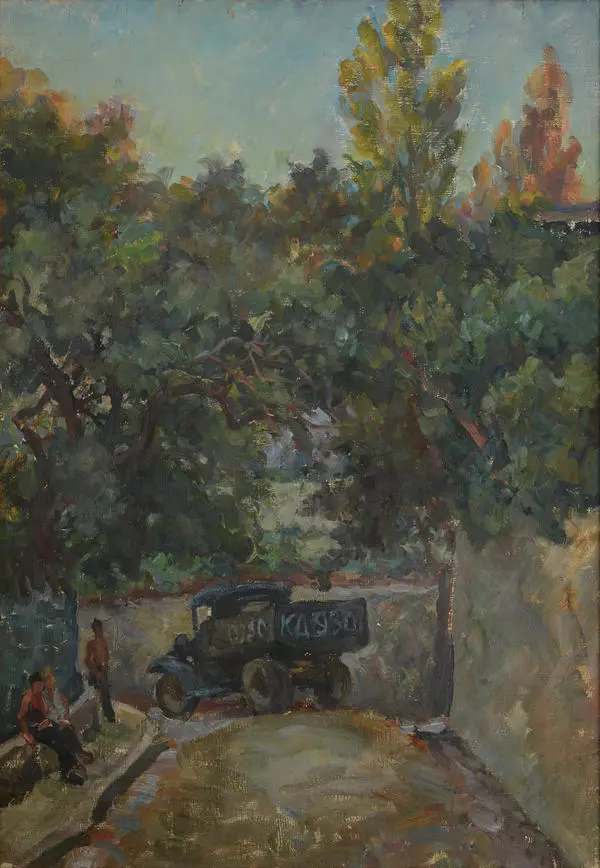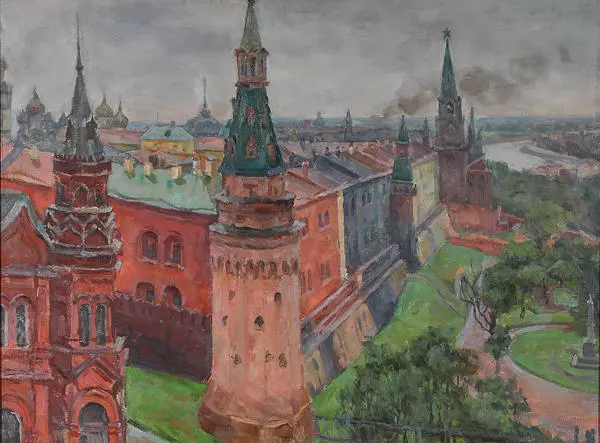The Russian artist Alexander Osmerkin was a long-time lecturer at the Leningrad Institute of Painting, Sculpture and Architecture named after Repin (former Imperial Academy of Arts). He was born in a Ukrainian town, Yelisavetgrad (now Kropyvnytskyi), and later lived in Moscow, Kiev and Leningrad. The artist was fascinated by the Northern Capital, and from the late 20s of the XX century he constantly painted architectural views, rivers and canals, White Nights, and famous residents of the city. He completed his painting In the backyard of the Hermitage in 1945, when he first visited the city after the end of the Siege.
In the backyard of the Hermitage
Время создания
1945
Размер
100x80 cm
Техника
Oil on canvas
Выставка
4
Открыть в приложении#3
Alexander Osmerkin
In the backyard of the Hermitage
#2
#6
The canvas shows a backyard between the Winter Palace and the Small Hermitage; the Palace Quay and the Neva can be seen through the arch. Osmerkin could not imagine Leningrad without its architectural heritage - in different years he painted the Academy of Arts building, Spit of Vasilyevsky Island view, New Holland Arch. However, the artist always avoided naturalistic literality: the Hermitage in this picture is recognized primarily due to its clear shape outlined by columns and cornices, while its rich decorations are painted casually and almost schematically.
However, it is not only architectural impressions that Leningrad was made of for Osmerkin. In 1927, he painted a realistic picture dedicated to the theme of the Revolution – Red Guards in the Winter Palace, and just before the war he created a portrait of Anna Akhmatova.
#8
Working on the painting In the backyard of the Hermitage, Osmerkin used very bright, vibrant colors, sometimes even without splitting them in different shades. This manner, which contradicted the post-war Soviet art canons, referred to the artist’s membership in the avant-garde association Jack of Diamonds – its members rejected academicism and the realistic style in painting. Osmerkin joined the group’s exhibitions in 1914. At that time, he was experimenting with modernist trends in painting: for his pictures Lady with a Lorgnette, Houses and Cities, Still Life with a Clock he used plain colors and an unusual perspective.
#11
The artistic daring of Osmerkin’s later works did not go unnoticed: in 1947, due to accusations of formalism and propaganda of the Western influence, he had to abandon teaching in Leningrad and Moscow. In the last years, the artist returned to a more traditional style: a year before his death, in 1952, he painted Still Life with a Weight Clock in the classic realistic technique.
Many famous Soviet painters were Osmerkin’s students: Ivan Godlevsky; Pen Varlen; Sergey Markin; Alexander Tikhomirov, author of the largest portrait of Lenin; and many others. The muralist Alexander Deyneka called Osmerkin a man of absolutely pictorial hearing and Don Quixote from the world of art, who was never preoccupied with practical thoughts and utilitarian matters.
#12
Orenburg Regional Museum of Fine Arts
читать дальшескрыть
00:00
00:00
1x
In the backyard of the Hermitage
Время создания
1945
Размер
100x80 cm
Техника
Oil on canvas
Выставка
4
Открыть в приложении
Поделиться





